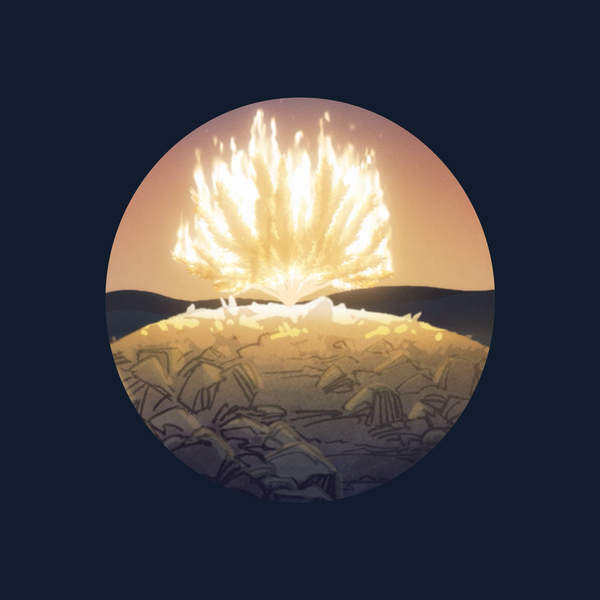
Moses, Israel, and the S’neh Tree
Episode Chapters
Show Notes
Quote
Here’s a new Noah going up to a mountain of God, and he’s talking like Abraham. The three narratives of high places with trees—Eden, Mount Ararat, Mount Moriah—are being hyperlinked in this scene. They’re all supposed to come together in your imagination.
Key Takeaways
- The story of Moses repeats key themes from the stories of the garden, Noah, and Abraham.
- God tests the people of Israel in the wilderness and at the mountain to see whether they will listen to his voice or choose to take wisdom into their own hands.
- Moses becomes the first image of someone who willingly offered themselves as a sacrifice on behalf of the rebellion of others.
Trees, High Places, And Sacrifice
In part one (0:00–9:00), Tim and Jon recap the conversation so far. High places symbolize where humans experience the presence of God, and the trees bring a moment of decision. Will they trust God’s wisdom or sieze wisdom on their own terms? Humanity chooses autonomy, and death and exile is the inevitable result. God promises that a seed of the woman will overcome evil at its source while also suffering the deadly consequences of humanity’s rebelion. The Bible sets us up for this hope of one who will sacrifice themselves to bring people into the presence of God. This is a motif that is developed in the stories of Noah, Abraham, and Moses. Noah trusts God when he builds an ark and upon being delivered, offers a sacrifice in thanks and intercession. Abraham passes the test when he listens to God’s voice to sacrifice his son. And the story of Moses carries these motifs even further.
Moses And The S’neh Tree
In part two (9:00–36:30), Tim and Jon talk about Moses and the people of Israel in the book of Exodus. Moses is introduced as a new Noah figure. He passes through the waters of death as a new Noah.
Exodus 2:1-3
Now a man from the house of Levi went and took a daughter of Levi. The woman conceived and bore a son; and when she saw that he was good, she hid him for three months. But when she could hide him no longer, she got him an ark of reeds and covered it over with tar and pitch. Then she put the child into it and set it among the reeds by the bank of the Nile. Later, Moses escapes into the wilderness for forty years. He wanders up onto a high mountain where he meets the presence of God burning in a s’neh tree.
Exodus 3:1-6
Now Moses was pasturing the flock of Jethro his father-in-law, the priest of Midian; and he led the flock to the west side of the wilderness and came to Horeb, the mountain of God. The angel of the Lord appeared to him in a blazing fire from the midst of a bush (Heb. s’neh // סנה); and he looked, and behold, the bush was burning with fire, yet the bush was not consumed. So Moses said, “I must turn aside now and see this marvelous sight, (Heb. Mar’eh // מארה) why the bush is not burned up.” When the Lord saw that he turned aside to look, God called to him from the midst of the bush and said, “Moses, Moses!” And he said, “Here I am.” Then he said, “Do not come near here; remove your sandals from your feet, for the place on which you are standing is holy ground.” He said also, “I am the God of your father, the God of Abraham, the God of Isaac, and the God of Jacob.” Then Moses hid his face, for he was afraid to look at God. The burning bush merges the images of the tree of life and the fire of God’s presence into one image. The story of Moses also links back to Abraham and Isaac, when God called Abraham twice and Abraham responded, “Here I am.” In this moment, themes from Eden, Noah, and Abraham all overlap. And just as in these previous narratives, this becomes a moment of testing for Moses. Will he trust God’s wisdom or do things his own way? God commands Moses to tell Pharaoh to release the people of Israel so that they can worship God at the mountain. In other words, Moses is called to bring the people to experience what he himself experienced on the mountain. Israel is delivered through the waters, escapes into the wilderness, and meets God at the mountain, just like Moses. But before they get to the mountain, they face a test.
Exodus 15:22-27
Then Moses Led Israel From The Red Sea, And They Went Out Into The Wilderness Of Shur; And They Went Three Days In The Wilderness And Found No Water. When They Came To Marah, They Could Not Drink The Waters Of Marah, For They Were Bitter; Therefore It Was Named Marah. So The People Grumbled At Moses, Saying, “what Shall We Drink?” Then He Cried Out To The Lord, And The Lord Showed Him A Tree; And He Threw It Into The Waters, And The Waters Became Sweet.
There God made for them a statute and regulation, and there he tested them. And he said, “If you will listen to the voice of the Lord your God, and do what is right in his sight, and give ear to his commandments, and keep all his statutes, I will put none of the diseases on you which I have put on the Egyptians. For I, the Lord, am your healer.”
Then They Came To Elim (“oak Trees”) Where There Were Twelve Springs Of Water And Seventy Palm Trees, And They Camped There Beside The Waters.
Tim points out that the tree God shows Moses becomes the vehicle of salvation for the people. This moment was a test, and Moses is the only one who passes. He keeps the laws of the covenant before they were given by listening and obeying God’s voice. Moses passes the test on behalf of the people, which then leads them into an Eden oasis.
Israel’s Test Before The Tree
In part three (36:30–47:00), the guys look at Exodus 19. It opens with the people of Israel arriving at the wilderness of Sinai (Heb. סיני), which recalls Moses’ meeting with God at the s’neh bush. Now the mountain is called by the name of the tree. God shows up for the people just as he showed up for Moses––as a blazing fire.
Exodus 20:18-20
All the people perceived the thunder and the lightning flashes and the sound of the trumpet and the mountain smoking; and when the people saw it, they trembled and stood at a distance. Then they said to Moses, “Speak to us yourself and we will listen; but let not God speak to us, or we will die.” Moses said to the people, “Do not be afraid; for God has come in order to test (Heb. נסי) you, and in order that the fear of Him may remain with you, so that you may not sin.” The test for the people of Israel has become the tree of life—to come into the presence of God.
Self-sacrifice And False Trees Of Life
In part four (47:00–end), Tim and Jon talk about the covenant that God gives to Moses to share with the people. Israel agrees, but while Moses goes back up the mountain, the people break God’s covenant. At the foot of a high place, the people create a false god in a false Eden and fail the test.
Exodus 32:30-33
On the next day Moses said to the people, “You yourselves have committed a great sin, and now I am going up to the Lord; perhaps I can make atonement for your sin.” Then Moses returned to the Lord, and said, “Alas, this people has committed a great sin, and they have made a god of gold for themselves. But now, if you will, forgive their sin—and if not, please blot me out from your book which you have written!” The Lord said to Moses, “Whoever has sinned against me, I will blot him out of my book.” In response to the sin of the people, Moses goes back up the high place into God’s presence. But instead of offering an animal sacrifice to make atonement, Moses offers himself. Moses isn’t ultimately the one to atone for the people’s sacrifice, but he put himself in a position of self-sacrifice. The crafting of idols mirrors the image of humans taking from the tree of life. Jon points out that this is consistent with human nature today when we look to any other source of power to serve us. Tim shares that later moments in Israel’s history point back to this moment, like when Jeroboam sets up two temples with a golden calf in each under a new priesthood. These later references to high places refer to Asherah, the fertility goddess symbolized in a luxuriant tree. These ancient and modern idols represent us replacing our allegiance for salvation.
Scripture References
Referenced Resources
Check out Tim's library here. You can experience our entire library of resources in the BibleProject app, available for Android and iOS.
Show Credits
- Defender Instrumental by Tents
- Sundown by Aarbor x Aarigod
- Daylight by Jay Someday
- Coniferous by Kupla Show produced by Dan Gummel and Tim Mackie. Powered and distributed by Simplecast.

